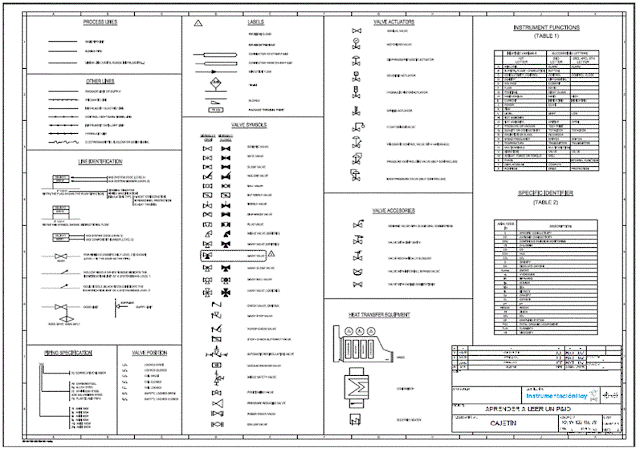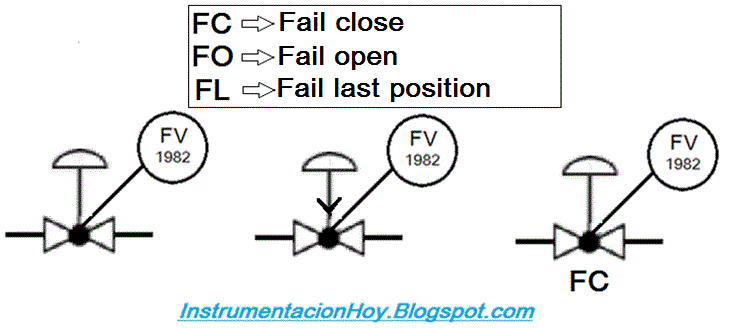1.1. WHAT IS A P&ID?
1.2. P&ID SYMBOLOGY LEGEND
1.3. INSTRUMENTS AND EQUIPMENTS IN P&ID
1.3.1. Local indicators in P&ID
1.3.2. Transmitters in P&ID
1.3.3. Switches in P&ID
1.3.4. Valves in P&ID
1.3.5. Other equipments in P&ID
1.4. P&ID TYPICAL INSTRUMENT DRAWINGS
1.5. P&ID TYPICAL VALVE DRAWINGS
1.6. P&ID CODES
1.6.1. P&ID instrument codes
1.6.2. P&ID pipe codes
1.7. P&ID CONTROL LOGICS
1.8. P&ID SCOPE INDICATIONS
1.9. P&ID TITLE BLOCK
1.1. WHAT IS A P&ID?
The fist lesson that I have learned and the first lesson that I usually teach to new mates is "How to read a P&ID".
Furthermore, explain a P&ID is a very common test in a technical interviews related to industrial process control.
What is a P&ID? It is "Pipe And Instrumentation Diagram"
As its name suggests "P&ID" is a diagram where It is represented pipes, instruments, valves, pumps and other devices; It is indicated also nominal diameters, rating, identification names, materials, fluids, control logic...etc.
P&ID example:
The P&IDs are drawn by the process department and supported by the other departments.
There is always an oficial copy, It is called "P&ID Master". The location of this copy is usually with process department.
Sometimes instrument department has its official copy where is indicated the instrument department comments.
Periodically, each department will indicate theirs changes and relevant annotations to the "P&ID Master".
Coordinate this action with an standard way and report to every affected people on time, is one of the most important point that should be managed in an engineering.
1.2. P&ID SYMBOLOGY LEGEND
The first P&ID in a project is the symbology legend sheet.
The symbology legend drawings are similar in each project and according to ISA standard (See ISA-5.1).
If It were your first day working as instrumentation engineer, I recommend you to study the project symbology legend sheet. It will help you to interpret the P&ID drawings and understand the scope of the project.
P&ID symbology legends examples:
1.3. INSTRUMENTS AND EQUIPMENTS IN P&ID
As I said at the beginning, the instruments and equipments are implemented in the P&ID, the following pictures are some instrument representation examples.
1.3.1. Local indicators in P&ID
The local indicators show us the measured values in the equipments and process lines. The local indicators will be very useful for the maintenance and the production staff.
Examples:
1.3.2. Transmitters in P&ID
The transmitters send the measured values to the control cabinets, allowing us to control and monitor the process. These devices can be specified with a local indicatios.
Examples:
1.3.3. Switches in P&ID
The switches send a digital signals when the measured variable reaches a certain value.
The "switches" may trip for high or low value.
Examples:
1.3.4. Valves in P&ID
The control valves and manual valves will be drawn in the P&ID diagrams. These equipments are used to control the flow in the process lines.
Examples:
1.3.5. Other equipments in P&ID
P&ID example:
1.4. P&ID TYPICAL INSTRUMENT DRAWINGS
The instruments usually have: the sensor (transducer) and the transmitter.
Temperature transmitter example:
The sensor (transducer) interprets the measured variable and converts it to other measurable energy.
For example a resistance temperature detector transducer (PT100) converts the temperature in a resistance value. This value is not usually sent directly to the control cabinet, instead it is converted in a head-mounting transmitter. The transmitter sends the final signal (4-2mA HART usually) to the control cabinet.
The head-mounting transmitter can be represented like the following drawings:
Also, It can be indicated with the transducer or the thermowell.
If the temperature transmitter isn’t head-mounting, the transmitter can be installed in the cabinet or in a junction box.
The "flow transmitters" can be represented with different drawings.
It can be indicated the transmitter or the transmitter and the primary flow element.
Some examples:
1.5. P&ID TYPICAL VALVE DRAWINGS
We are going to divide the valve types in five groups:
Valves and actuators can be represented with different drawings like the instruments, for example:
With or without Positioned & Actuator:
With or without handwheel:
With the fail position:
With the status during normal operation:
1.6. P&ID CODES
Every projects usually follow more or less, the same coding guidelines thaht are supported by the ISA or other standard as the KKS.
If we define a correct coding criteria, we could save a lot of time.
The codes apply to equipment, signals, alarms, valves, trays, control and electrical cabinets, junction boxes, instruments, pipes, cables ...etc.
1.6.1. P&ID instrument codes
In the example, the “TAG” (name) is "20-FT-1982-A". This code will not be repeated for other plant devices.
-First part: “the Unit”. It indicates two digits "20". The instrument is installed in the unit “20”. To split the project in different units is very common in Oil & Gas big projects, however, it is less common in power plants.
Note: (An instrument department manager told me one day) " The secret to solve a complex problem is to know how to split the problem in smaller parts"
-Second part: "the instrument type”. It indicates two letters "FT". It is a flow transmitter.
Other examples:
AT - Analyzer / FT - Flow transmitter / TT - Temperature transmitter / LT - Level Transmitter
-Third part: “the Loop Number”. It indicates "1982". Each control loop is named with a sequential number. A “Loop” is a set of devices with a control logic link.
Control Loop example:
-Fourth part: “Suffix”. “A” indicates that there is a redundant device at least, as the "A" and "B" in the previous drawing.
Redundant equipments are defined in critical loops. If a device is not working, the loop control will use the redundant one.
1.6.2. P&ID pipe codes
-First part: “Size”. It indicates "2" (nominal diameter two inches).
-Second part: “Fluid Type” It indicates "GI" (nitrogen).
-Third part: “Sequential Number”. It indicates "45455".
-Fourth part: “Pipe specification” It indicates "1S5". We can find the code meanings in the Project document: "pipe specification".
In these case: "1" -> Rating 150# / "S5" -> Pipe material stainless steel.
1.7. P&ID CONTROL LOGICS
In the following drawings is indicated a part of P&ID control logics.
All control logics can not be detailed in a P&ID. There are other specific documents, as functional descriptions or control strategy.
In general, the control logics are easier to draw in Oil&Gas P&ID (where the control loops are more simples) than electrical power plant (where every control loops are interconnected)
In the picture below: "There is a flow transmitter that sends a hardwired signal to the control system and the control system monitors the measured value"
In the picture below: "There is a flow transmitter that sends a hardwired signal to the control system and the control system monitors the value and it will generate two alarms, if there are low flow value or high flow value "(The alarms could be represented by a hexagon too)
In the picture below: "There is a flow transmitter and a control valve whose signals are wired to the control system. The control system monitors the flow rate and use the process value in a internal PID that controls the valve position.
In the picture below: "There is an off valve. It is wired to the control system. The valve can be opened or closed by a plant operator through a "HS" (Hand Switch).
A "HS" is a configurated button in the SCADA screen.
In the picture below: "There is a pressure gauge, a motor-pump and an on-off valve. If the measured pressure is below a fixed value, an alarm is generated by the control system and it will active an "Interlock signal". The interlock will stop the pump, and it will close the valve.
1.8. P&ID SCOPE INDICATIONS
The scope of “black-box suppliers” should be represented in the P&ID.
“Black-Box” is a devices group installed and supplied by the same vendor.
If you are designing a plant you should coordinate that “black-boxes” limits fit with the rest of the devices.
1.9. P&ID TITLE BLOCK
P&IDs must have a standard title-block as other project oficial drawings.
Note: It has been tried to collect into this report some basic concepts to help anyone who begins to walk on the instrumentation way. It is always an honor to teach someone who want to learn.
In this article, I would like to thank those professionals who have repeatedly explained us and will continue to explain you all over again what the instrumentation and control is. As conclusión, I would like to give you two messages:
1º- For those who have carried on working as engineers for several years, I honestly belive that part of your duty is to maintain the excitement to learn in the young people (even prioritizing this vs. a project).
2º- For the beginners, don’t let anyone to take your hunger to learn and improve.







































Thank you so much for your published article. This is the best article I have read on P & ID especially with the graphical representation using actual devices and showing how they are connected in the field. You have certainly improved my process virtualization. I was actually struggling with how alarms are hardwired to process systems. Reading your article has solved my problems. Thank you once again for sharing your knowledge
ReplyDeleteThanks boss its very very important for us to know so i came know thought your guide line by shearing publicly your p&id knowledge keep on doing the same .
ReplyDeleteBest article on P&ID I've ever read. Thanks so much! and keep up the good work.
ReplyDeleteBest topic about P&ID I've ever seen. Good job! Thanks alot!
ReplyDeleteWonderful! P*ID explained in easiest way.
ReplyDeleteThanks for the info! Sure wish I would have gone through this before I attempted the assignments! lol. Now I know. We live and we learn!
ReplyDeleteIt's really useful, you save me. Thanks very much!
ReplyDeleteNiceeeeeeee
ReplyDeletePerfect article indeed, many thanks
ReplyDelete
ReplyDeleteThanks For Sharing This Informative Article.
p and id
Thanks for sharing this article. It's Very helpfull Sir,.....
ReplyDeleteThanks For Sharing This Informative Article.
ReplyDeletehello,
ReplyDeleteI have a question. I want to mark on the schematic symbol valves (automatic on/off). Can i mark it as a function valve (FV)?
Hand valve mark it HV, control valve CV, and valve that is automatic but not Control valve, only on / off (but automatic) how to mark correctly on p&id schamtic.
Respect and that i have a tremendous proposal: Who Repairs House Windows house renovation on a budget
ReplyDeleteYou are the best, and this is the best PID education material in the world
ReplyDelete